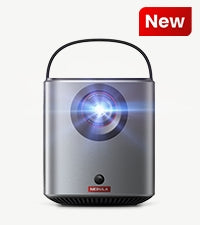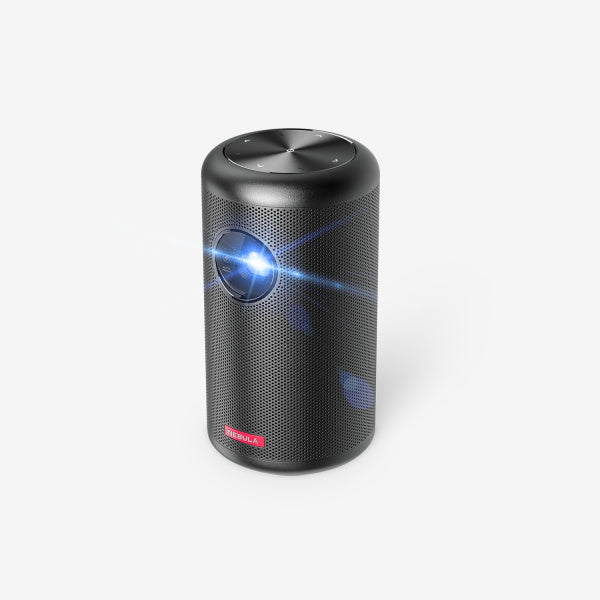You're setting up a home theater or gearing up for a presentation. The question looms: projector screen vs wall—which canvas deserves the limelight?
It's a question that has both casual movie watchers and professional presenters scratching their heads.
But worry not, this article is your one-stop guide to solving this dilemma. By the end, you'll be well-equipped to make an informed decision that meets your unique needs and environment.
Let's get cracking.

Projector Screen vs Wall: What Are the Differences
Ever pondered during movie night, "Screen or just the wall?" While both can showcase your favorite flicks, there's more to it than meets the eye. Let's break down the real differences between using a projector on a wall vs. a screen.
Material and Visual Performance
Projector Screen: Crafted with materials designed to optimize image quality, screens ensure uniform light reflection, vibrant colors, and sharp images. They offer smooth and consistent surfaces and often include special coatings to enhance visual fidelity and color accuracy.
Wall: Standard wall paints are not optimized for projections, often leading to less vibrant or slightly skewed colors. Surface imperfections such as bumps, cracks, or varying textures can cause visual distortions.
Adaptability and Flexibility
Projector Screen: Offers versatility with options for retractable and portable models, accommodating different spaces and purposes. While there are various sizes available, each screen has fixed dimensions.
Wall: The location is fixed, which can be limiting if you wish to change or move the projection area. However, using a projector onto white walls provides an unrestricted canvas, allowing for expansive and custom-sized displays.
Ambient Light Rejection (ALR)
Projector Screen: Many modern screens come with ALR capabilities, meaning they can reflect the projector's light while absorbing or deflecting other ambient light sources. This ensures a clearer image even in well-lit rooms.
Wall: The image quality on a projector white wall can be compromised in well-lit rooms due to the lack of ALR properties, resulting in a potential wash-out effect.
Cost Implications
Projector Screen: Requires an initial investment but delivers enhanced durability and a consistent, high-quality viewing experience.
Wall: Cost-effective but may require specialized paints or treatments to improve image quality, incurring additional expenses.
Overview of the Advantages of Projector Screen and Wall
Now that we have unpacked the distinctive features and potential limitations of white walls vs. projector screens, let's pivot to explore the unique advantages each option brings to the table. This will further illuminate your decision, enabling you to choose a surface that complements the smart projector you just invested in, ensuring optimal performance and visual experience.
Advantages of a Projector Screen:
- Optimized Viewing Experience: Screens are designed to maximize the viewer's experience with enhanced brightness, contrast, and color fidelity.
- Uniform Surface: Screens provide a smooth, even surface, ensuring that the projected image doesn't have any distortions.
- Versatility: With options like motorized, pull-down, or portable screens, they cater to various needs and environments.
- Professional Appearance: For settings like corporate presentations, a dedicated screen often appears more polished and professional.
Advantages of Using a Projector on White Wall:
- Cost-Effective: No need for an additional purchase if your wall is smooth and in good condition.
- Easy Setup: No installation is needed; just project directly onto a clean, white wall for projector.
- Minimalistic Design: For those seeking a clean, uncluttered look in their space, projecting directly onto a wall eliminates the need for extra equipment.
- Adjustable Size: The projection size can be easily adjusted without the constraints of a physical screen frame.

Tips When Using a Projector Screen
Having delved into the advantages, if you're leaning towards a projector screen, it's paramount to know how best to utilize it. Whether you're looking to purchase a ready-made option or exploring how to make a projector screen tailored to your specific needs, let's ensure you get the most out of your choice.
1. Select the Appropriate Screen
Material: Opt for a material that complements the room's lighting conditions. Different materials offer varying levels of brightness and contrast.
Color: Matte white screens for projectors are a common choice for diverse environments, while gray screens enhance contrast, ideal for spaces with ambient light.
Aspect Ratio: Tailor this to your primary content type; 16:9 is standard for modern media, while 4:3 is geared towards classic films and presentations.
2. Position Properly
Aim to position the center of the screen at the average eye level of seated viewers to maximize comfort and visibility. When mounting the projector screen on a wall, particularly, it's crucial to install it at the right height to ensure an unobstructed view.
3. Optimize Settings and Conditions
Projector Calibration: Align the projector's settings, especially focus and color calibration, with the screen's specifications to enhance image quality.
Lighting Conditions: Assess and adjust room lighting to match your screen, utilizing dimmable and strategically positioned lights to control brightness and direction, minimizing glare and enhancing image quality.
4. Clean Regularly
Use a soft cloth to remove dust and dirt gently. This prevents buildup that can reduce reflectivity and image clarity. Always follow the manufacturer's recommendations to avoid damaging the screen material.
Conclusion
When comparing a projector screen vs wall, both have their unique advantages and limitations. A projector screen is designed for optimal visual performance, offering enhanced color accuracy, brightness, and a consistent viewing experience. It's the top choice for those seeking the best projection quality. Meanwhile, projecting onto a wall is a cost-effective and adaptable option. While it might not provide the peak performance of a dedicated screen, it can be satisfactory for casual viewings or in settings where perfect image fidelity isn't crucial. The key is understanding one's needs and making an informed decision based on that.
FAQ
Are Projector Screens Better for Your Eyes?
Yes, projector screens can be better for your eyes. They often offer a larger viewing area and use reflected light, reducing glare and intensity of light compared to direct light from traditional TVs or monitors, potentially leading to less eye strain. However, the viewing environment, screen quality, and image brightness also play significant roles in overall eye comfort.
Do You Really Need a Projector Screen?
No, you don't necessarily need a projector screen, but having one can significantly enhance the image quality. Projector screens are designed to reflect light more efficiently, offering a brighter, clearer, and more color-accurate image compared to projecting on a wall. They also provide a smooth, flat surface, reducing distortions for a better viewing experience.
Is a white wall good for projector?
A white wall can serve as a makeshift projector screen; many people use it for casual viewing. However, it might not provide the same color accuracy, brightness, or clarity level as a screen specially designed for projecting images.






























